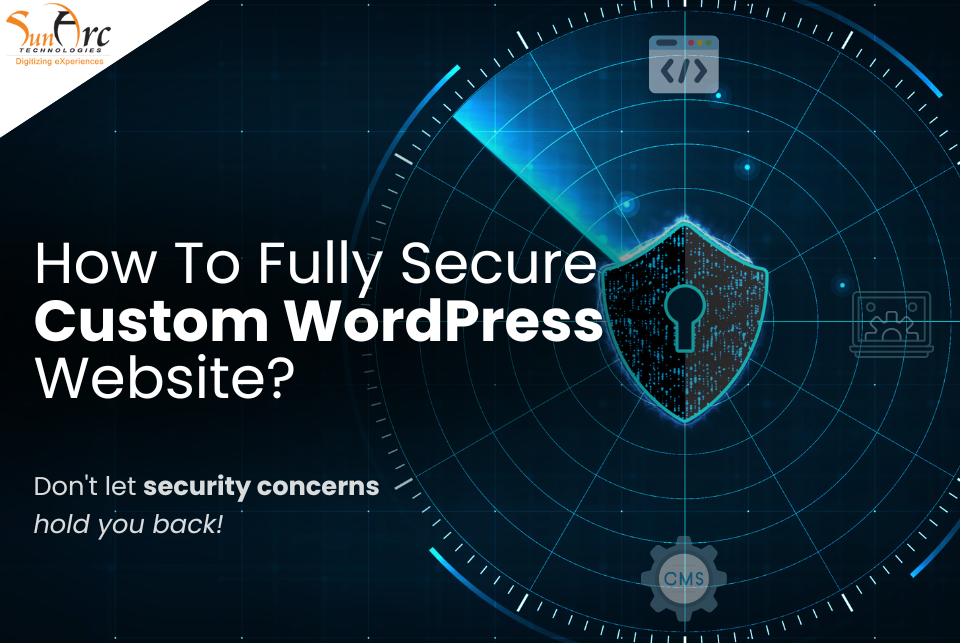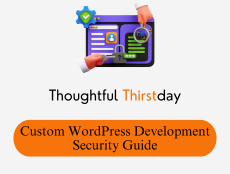WordPress is one of the most widely used platforms for creating websites. Those who want to go the extra mile for extra profits go with customized WordPress development as per their business requirements. Here, the security of WordPress websites is the prime concern. Every WordPress website owner becomes a victim of a data breach at some point in his online business.
Businesses encounter unique challenges in maintaining the security of their custom WordPress websites. These challenges range from safeguarding sensitive user data to thwarting potential attacks aimed at disrupting the site’s smooth operation.
In this thoughtful Thirstday blog, we’ll explore the complexities of custom WordPress development website security, highlight typical mistakes, and give practical solutions to strengthen your website’s defenses.

Here we go..!!
Unique Security Challenges in Custom WordPress Development
1. Security Flaws in User-Created Code
Writing custom code is a common part of custom WordPress development, which allows developers to make the platform work for unique needs.
On the other hand, without enough validation and sanitization, this custom code might expose vulnerabilities. It is the developer’s responsibility to make sure the code is safe and can withstand typical attacks like SQL injection, XSS, and unsafe file transfers.
2. Threats from Third-Party Plugins
Third-party plugins can be easily integrated into WordPress through its vast plugin ecosystem, allowing for the addition of functionality to the website. Nevertheless, there is a possibility of security issues when depending on plugins that are not developed or maintained by the original developers. To reduce the possibility of security breaches, it is important to carefully evaluate how to integrate and manage third-party plugins.
3. Limited Control over Core Updates
While WordPress regularly releases security updates to address vulnerabilities in its core software, custom WordPress development may involve modifying core files or functionality.
The ability to quickly apply core upgrades without affecting customizations is therefore compromised. Developers must walk a fine line between the necessity of security fixes and the maintenance of user-defined features.
4. Lack of Security Expertise
It might be challenging for small businesses or individual website owners to have the required cybersecurity skills to ensure the security of their custom WordPress sites. This might lead to insufficient security measures being put in place, which can make the website vulnerable to attacks. It is important to educate website owners and developers on security best practices in order to reduce this risk.
5. Complexity of Maintenance
Compared to sites created with pre-made themes or templates, custom WordPress development are often more complex. To keep security measures effective over time, it is necessary to devote more effort and attention to maintaining and upgrading custom WordPress sites. To deal with new security risks, it is crucial to conduct audits and perform maintenance on a regular basis.
6. Targeted Attacks
Sites built using WordPress are vulnerable to targeted attacks from cybercriminals who are looking to steal sensitive information or exploit security flaws. Customers’ private information, financial details, or even intellectual property might be at risk. Custom WordPress websites require strong security measures since they are prone to advanced attacks due to their personalized nature.
Read more: Why Is Custom WordPress Development Important For Your Business?
Robust Security Measures for Custom WordPress Websites
1. Use Strong Passwords
It is recommended that users generate robust passwords that include a mix of uppercase and lowercase letters, digits, and special characters.
You may make WordPress adhere to security standards by instituting policies that mandate minimum password length and complexity and changing them frequently.
The best way to protect your account from brute force attacks is to implement an account lockout policy that locks users out after a specific amount of unsuccessful login attempts.
2. Enable SSL/TLS Encryption
In order to secure data communicated between the web server and the browsers of site users, it is necessary to acquire and install an SSL/TLS certificate from a reliable Certificate Authority (CA).
For safer server-client connection, set WordPress to use HTTPS instead of HTTP.
You can make sure that all connections are encrypted by setting up redirects to automatically redirect HTTP traffic to HTTPS.
3. Update Your Software Regularly
Keep WordPress, its themes, and plugins up-to-date on a regular basis to fix security holes and prevent attacks.
When it is feasible, set up automated updates for WordPress core, themes, and plugins. This will make sure that security patches are installed on time.
Keep yourself updated on new security dangers by keeping an eye on the announcements made by WordPress and plugin developers.
Read more: Breathe Life Into Your Website With The Customized WordPress Theme
4. Implement Web Application Firewalls (WAF)
In order to prevent typical attacks such as SQL injection, cross-site scripting (XSS), and distributed denial-of-service (DDoS), it is recommended to implement a web application firewall (WAF) to filter and monitor incoming web traffic.
Choose a WAF that works well with WordPress and has all the security features you need, like customized rule sets and real-time threat intelligence.
5. Utilize Security Plugins
Wordfence, Sucuri, or iThemes Security are some trusted security plugins that you may install on your custom WordPress website to ensure its safety.
Wordfence Security: A comprehensive security plugin that provides firewall protection, malware scanning, and login security features.
Sucuri Security: Offers website security monitoring, malware removal, and website firewall to protect against various online threats.
Solid Security: Helps in securing custom WordPress websites by detecting and fixing common security vulnerabilities, implementing brute force protection, and enhancing user credentials.
Configure security plugins to perform regular malware scans, firewall protection, login security, and file integrity monitoring.
Enable features like brute force protection, IP blocking, and security notifications to detect and mitigate security threats proactively.
6. Enable Two-Factor Authentication (2FA)
Adding two-factor authentication (2FA) can enhance the security of user logins by providing an additional layer of protection. Select a 2FA method in the custom WordPress development phase that offers convenience to users, such as SMS codes, authenticator apps, or hardware tokens.
We highly recommend that all users, including administrators and privileged users, activate 2FA for their accounts.
To enforce two-factor authentication for specific user roles or for login attempts from unfamiliar devices or locations, you can configure the settings in WordPress or utilize plugins.
7. Implement File Permission Restrictions
Ensure that the file permissions on server files and directories are properly configured to limit access and protect against unauthorized changes or the execution of malicious code.
Use the principle of least privilege while custom WordPress development to grant only the necessary permissions to users and processes required for their respective tasks.
It is important to regularly check file permissions and review access control lists to make sure they align with security policies and standards.
Keep track of any changes to the file system and modifications to permissions by utilizing file integrity monitoring tools or security plugins.
8. Regularly Backup Your Website
Make sure you have a strong backup plan in place to regularly safeguard your WordPress website files, database, and configuration settings. Opt for a trustworthy backup solution that provides automated backups, incremental backups, and the ability to store data offsite.
Regularly test backup restoration procedures to verify the functionality and efficiency of restoring backups in case of a security incident or data loss.
It is important to securely store backups and keep multiple copies with varying retention periods to minimize the chances of losing data.
9. Keep Track of Your Website’s Activity.
Use security monitoring tools or plugins to keep track of and analyze website activity, such as login attempts, file changes, and traffic patterns.
Set up security monitoring alerts and notifications to quickly alert administrators of any suspicious activity or security incidents.
It is important to consistently review security logs, audit trails, and incident reports in order to detect security incidents, analyze their underlying causes, and implement necessary corrective measures.
Deploy intrusion detection systems (IDS) or intrusion prevention systems (IPS) to swiftly identify and block any malicious activities or unauthorized access attempts as they occur.
10. Educate Users
Provide comprehensive security training and awareness programs to educate users about common security threats, best practices, and policies.
Create user-friendly documentation or tutorials to guide users on security-related tasks such as password management, secure browsing habits, and incident reporting.
Encourage users to report security incidents, suspicious emails, or unusual activities promptly to the appropriate IT or security personnel.
Foster a culture of security awareness and accountability within the organization by rewarding good security practices and promoting a collaborative approach to security risk management.
Thoughts
Protecting your custom WordPress website from security threats is more than just a precautionary step—it’s an essential part of being a responsible digital caretaker. Businesses can greatly minimize their vulnerability to potential risks by placing a strong emphasis on security during the development process, following industry best practices, and promoting a culture of vigilance and learning among users and administrators.
Custom WordPress development provides remarkable adaptability and functionality. However, it is crucial to prioritize security and maintain a high level of diligence throughout the process. By recognizing the specific challenges presented by customizations and proactively addressing vulnerabilities, businesses can strengthen their online presence and safeguard their valuable assets from being exploited.
If you are in the phase of launching your WordPress website, follow all the recommendations suggested in this blog, and if you need assistance in custom WordPress development, you can contact us; our team of expert WordPress developers is here to help you.

